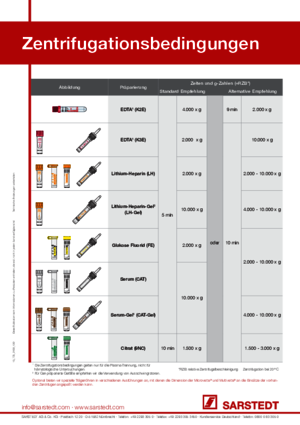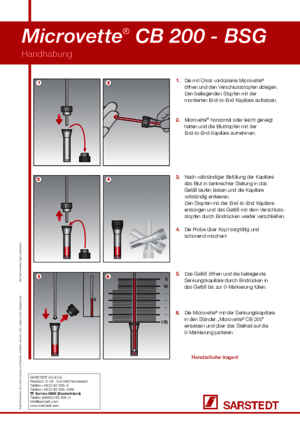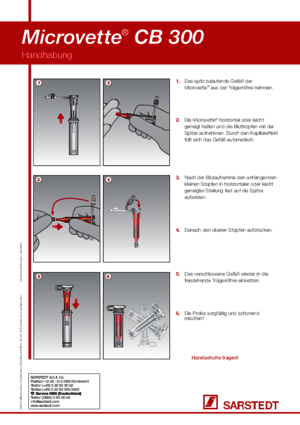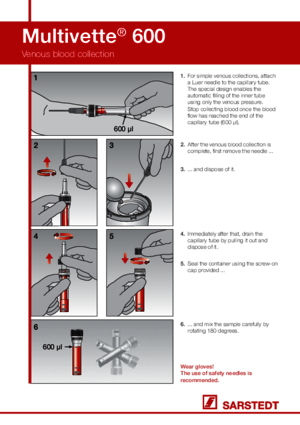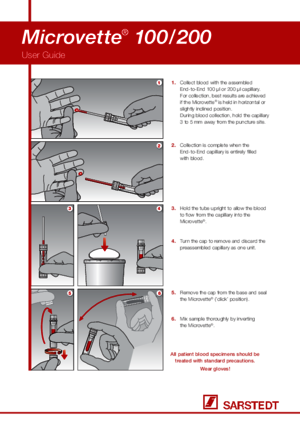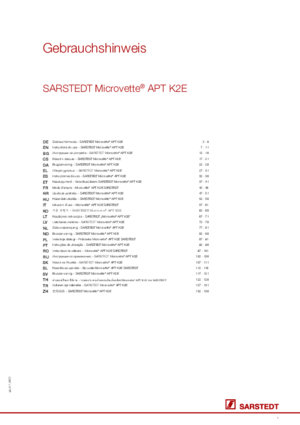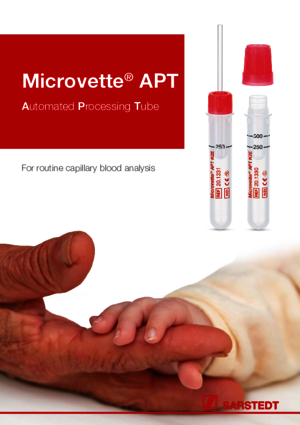
Microvette® APT Automated Processing Tube
Microvette® APT Automated Processing Tube
Language:

| Order number | 17.2113.150 |
|---|---|
| Product description | Minivette® POCT EDTA K3E, nominal volume: 50 µl, preparation: K3 EDTA, violet, colour code ISO, 200 piece(s)/bag, 200 piece(s)/case |
| Type of collection | capillary |
|---|---|
| Type of preparation | K3 EDTA |
| Colour code | ISO |
| Application | capillary blood collection |
| Coding colour | violet |
| Sample volume | 50 µl |
|---|
| Product material | Cellulose acetate (CA) |
|---|---|
| Colour of product | transparent |
| Product category | In vitrodiagnostic device, CE |
|---|---|
| CE certified | CE |
| Latex-free | yes |
| Batched | yes |
| Minimum order qty. | 2000 |
|---|---|
| Type of smallest subpackaging | bag |
| Piece(s) / inner box | 200 |
| Piece (s) / outer case | 2000 |
| Piece(s) / pallet | 144000 |
| Depth of box | 140 mm |
| Width of box | 99 mm |
| Height of box | 117 mm |
| Depth of case | 513 mm |
| Width of case | 293 mm |
| Height of case | 140 mm |
| Case volume | 0.021 cbm |
| Weight of product | 0.001 kg |
| Weight of case | 2.68 kg |
| EAN of inner box | 4038917320085 |
| EAN case | 4038917320078 |


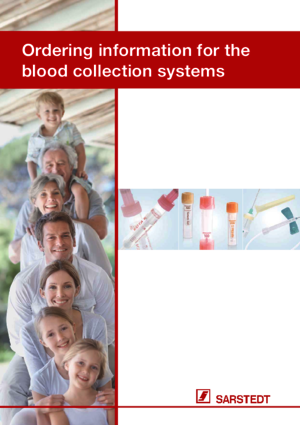
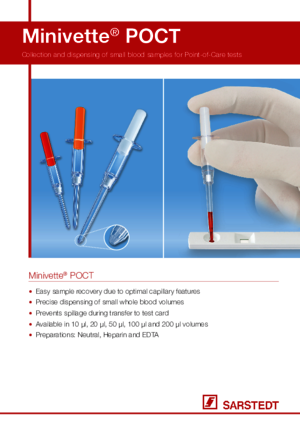

The Minivette® POCT is particularly suitable for the precise recovery and dispensing of defined small whole blood samples. This is especially required for Point-of-Care tests (POCT).
Both marks refer to the filling level. As the Multivette® is held horizontally and tilted slightly while collecting blood, the mark at the bottom of the Multivette® shows the correct filling level. After collection, the capillary tube is emptied through extraction. The filling level of an upright Multivette® can be read by the upper mark.
Both collection methods are possible with the Multivette®. The capillary tube has been developed so that either capillary blood can be collected directly with the self-filling capillary tube or venous blood can be collected by attaching a safety Luer needle to the capillary tube.
Capillary blood is not suitable for coagulation diagnostics. When collecting capillary blood, a certain amount of tissue fluid is also taken. This can result in false measurement values in coagulation analysis.
There are special carrier tubes available (e.g. product no 55.1570; 55.1572;55.1571) which enable adaptation for analysis systems and centrifuges.There are special carrier tubes available (e.g. product no 55.1570; 55.1572;55.1571) which enable adaptation for analysis systems and centrifuges.
When using the Microvette®, the user has a choice of two collection techniques. The blood can either be taken using the pre-assembled end-to-end capillary or with the special rim.
Yes, each Microvette® is labelled with an expiry date and lot number.
For serum, the optimal conditions are 5 minutes, 10,000 x g at 20°C. The recommended centrifugation conditions are printed on the labels of each inner box and are found on the Sarstedt website under Product Specifications.
For serum gel and lithium heparin gel, the optimal conditions are 5 minutes, 10,000 x g at 20°C. The recommended centrifugation conditions are printed on the labels of each inner box and can be found on the Sarstedt website under Product Specifications.
For lithium heparin, EDTA and fluoride, the optimal conditions are 5 minutes, 2000 x g at 20°C. The recommended centrifugation conditions are printed on the labels of each inner box and can be found on the Sarstedt website under Product Specifications.
The Microvette® has the ideal features for capillary blood collection, but it can also be used for venous blood collection. Alternatively, the prepared micro sample tubes with attached lid or screw cap can be used. These are ideal for venous blood collection.
The Microvette® CB 200 ESR (product no 18.1325) is ideal for measuring blood sedimentation from capillary blood.
Microvettes with conical inner tubes provide optimum pipetting of serum and plasma supernatants, even with small amounts of blood. The cylindrical inner tube makes it easier to mix the sample and enables optimal gel separation after centrifugation.
The CLSI standard (Clinical and Laboratory Standards Institute) recommends EDTA, heparin, heparin gel, fluoride, serum and then serum gel.
We would like to show you additional content which is hosted by a third party. For this purpose we need your consent to set cookies:
